Financial Management: Business Performance Analysis Report
VerifiedAdded on 2022/11/30
|10
|2554
|173
Report
AI Summary
This report provides a comprehensive overview of financial management, encompassing its core concepts and significance within an organization. It delves into the essential financial statements—balance sheet, income statement, and cash flow statement—explaining their structure and purpose in evaluating a company's financial health. The report emphasizes the practical application of financial ratios in assessing profitability, liquidity, and efficiency, using a case study to illustrate these concepts. Furthermore, it analyzes a business review template, interpreting financial data to assess the company's performance over two years. The report concludes by offering actionable strategies for improving financial performance, including managing liquidity, controlling overhead expenses, and optimizing capital structure, providing valuable insights for businesses seeking to enhance their financial outcomes. The report is a past paper contributed by a student to be published on the website Desklib. Desklib is a platform which provides all the necessary AI based study tools for students.
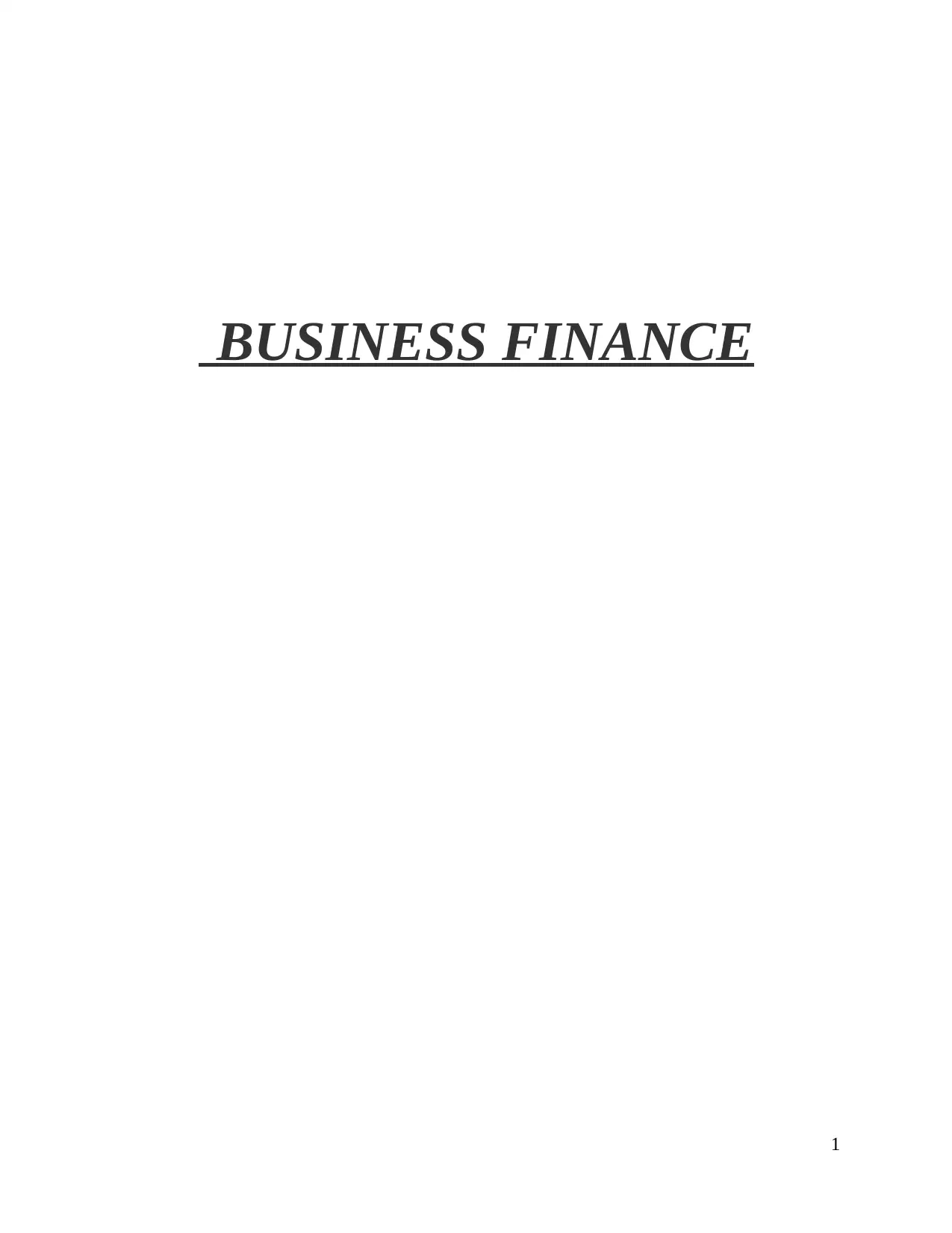
BUSINESS FINANCE
1
1
Paraphrase This Document
Need a fresh take? Get an instant paraphrase of this document with our AI Paraphraser
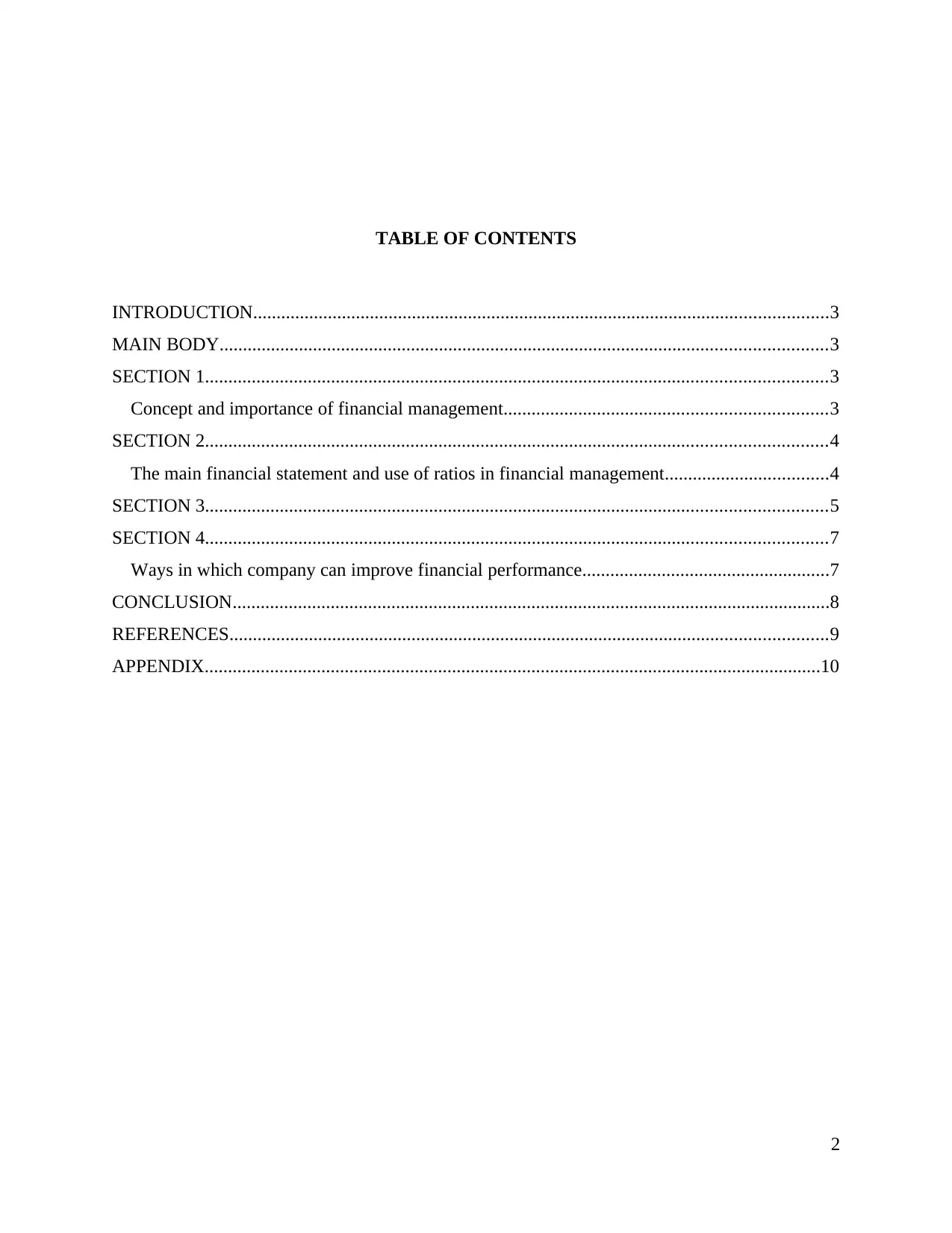
TABLE OF CONTENTS
INTRODUCTION...........................................................................................................................3
MAIN BODY..................................................................................................................................3
SECTION 1.....................................................................................................................................3
Concept and importance of financial management.....................................................................3
SECTION 2.....................................................................................................................................4
The main financial statement and use of ratios in financial management...................................4
SECTION 3.....................................................................................................................................5
SECTION 4.....................................................................................................................................7
Ways in which company can improve financial performance.....................................................7
CONCLUSION................................................................................................................................8
REFERENCES................................................................................................................................9
APPENDIX....................................................................................................................................10
2
INTRODUCTION...........................................................................................................................3
MAIN BODY..................................................................................................................................3
SECTION 1.....................................................................................................................................3
Concept and importance of financial management.....................................................................3
SECTION 2.....................................................................................................................................4
The main financial statement and use of ratios in financial management...................................4
SECTION 3.....................................................................................................................................5
SECTION 4.....................................................................................................................................7
Ways in which company can improve financial performance.....................................................7
CONCLUSION................................................................................................................................8
REFERENCES................................................................................................................................9
APPENDIX....................................................................................................................................10
2
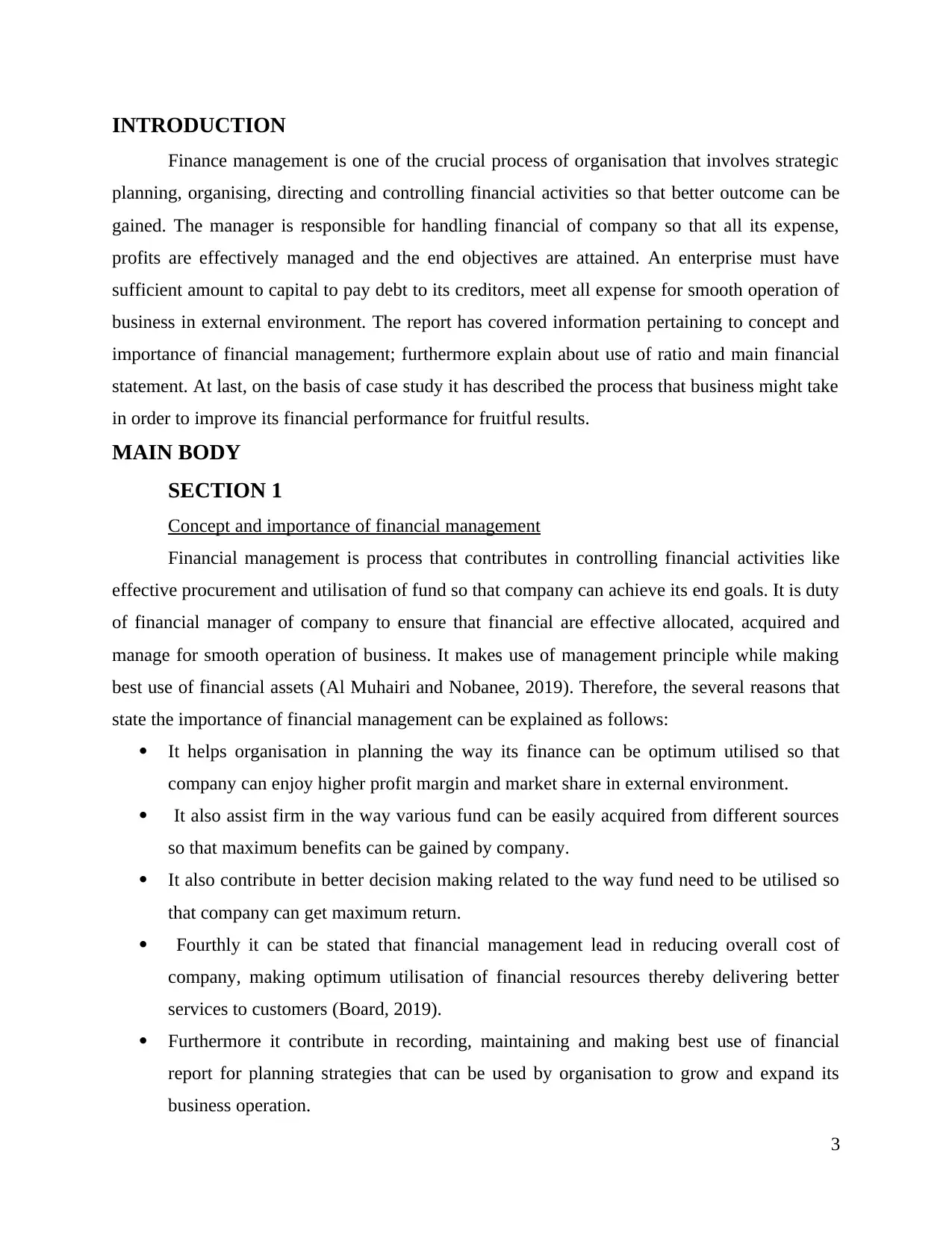
INTRODUCTION
Finance management is one of the crucial process of organisation that involves strategic
planning, organising, directing and controlling financial activities so that better outcome can be
gained. The manager is responsible for handling financial of company so that all its expense,
profits are effectively managed and the end objectives are attained. An enterprise must have
sufficient amount to capital to pay debt to its creditors, meet all expense for smooth operation of
business in external environment. The report has covered information pertaining to concept and
importance of financial management; furthermore explain about use of ratio and main financial
statement. At last, on the basis of case study it has described the process that business might take
in order to improve its financial performance for fruitful results.
MAIN BODY
SECTION 1
Concept and importance of financial management
Financial management is process that contributes in controlling financial activities like
effective procurement and utilisation of fund so that company can achieve its end goals. It is duty
of financial manager of company to ensure that financial are effective allocated, acquired and
manage for smooth operation of business. It makes use of management principle while making
best use of financial assets (Al Muhairi and Nobanee, 2019). Therefore, the several reasons that
state the importance of financial management can be explained as follows:
It helps organisation in planning the way its finance can be optimum utilised so that
company can enjoy higher profit margin and market share in external environment.
It also assist firm in the way various fund can be easily acquired from different sources
so that maximum benefits can be gained by company.
It also contribute in better decision making related to the way fund need to be utilised so
that company can get maximum return.
Fourthly it can be stated that financial management lead in reducing overall cost of
company, making optimum utilisation of financial resources thereby delivering better
services to customers (Board, 2019).
Furthermore it contribute in recording, maintaining and making best use of financial
report for planning strategies that can be used by organisation to grow and expand its
business operation.
3
Finance management is one of the crucial process of organisation that involves strategic
planning, organising, directing and controlling financial activities so that better outcome can be
gained. The manager is responsible for handling financial of company so that all its expense,
profits are effectively managed and the end objectives are attained. An enterprise must have
sufficient amount to capital to pay debt to its creditors, meet all expense for smooth operation of
business in external environment. The report has covered information pertaining to concept and
importance of financial management; furthermore explain about use of ratio and main financial
statement. At last, on the basis of case study it has described the process that business might take
in order to improve its financial performance for fruitful results.
MAIN BODY
SECTION 1
Concept and importance of financial management
Financial management is process that contributes in controlling financial activities like
effective procurement and utilisation of fund so that company can achieve its end goals. It is duty
of financial manager of company to ensure that financial are effective allocated, acquired and
manage for smooth operation of business. It makes use of management principle while making
best use of financial assets (Al Muhairi and Nobanee, 2019). Therefore, the several reasons that
state the importance of financial management can be explained as follows:
It helps organisation in planning the way its finance can be optimum utilised so that
company can enjoy higher profit margin and market share in external environment.
It also assist firm in the way various fund can be easily acquired from different sources
so that maximum benefits can be gained by company.
It also contribute in better decision making related to the way fund need to be utilised so
that company can get maximum return.
Fourthly it can be stated that financial management lead in reducing overall cost of
company, making optimum utilisation of financial resources thereby delivering better
services to customers (Board, 2019).
Furthermore it contribute in recording, maintaining and making best use of financial
report for planning strategies that can be used by organisation to grow and expand its
business operation.
3
⊘ This is a preview!⊘
Do you want full access?
Subscribe today to unlock all pages.

Trusted by 1+ million students worldwide
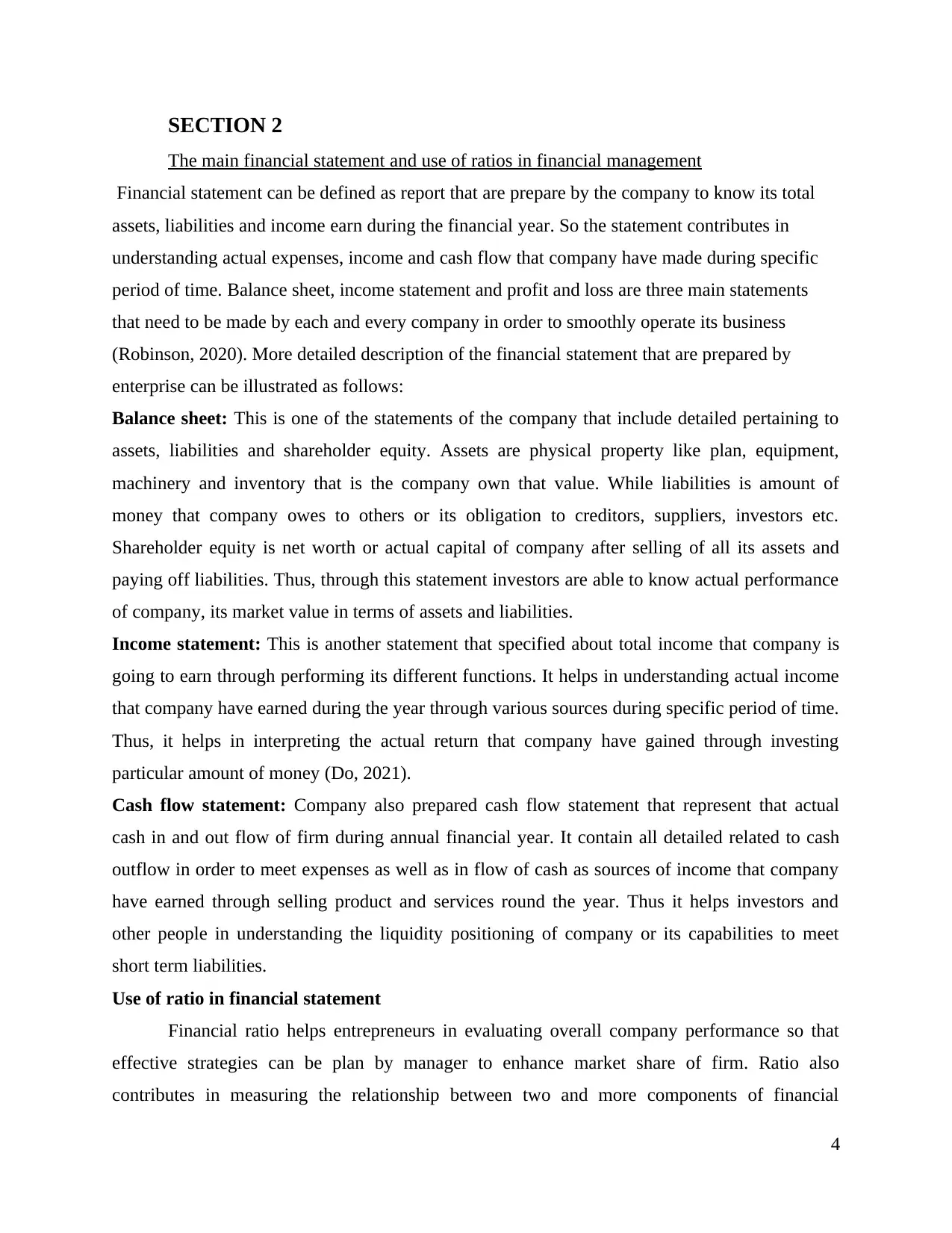
SECTION 2
The main financial statement and use of ratios in financial management
Financial statement can be defined as report that are prepare by the company to know its total
assets, liabilities and income earn during the financial year. So the statement contributes in
understanding actual expenses, income and cash flow that company have made during specific
period of time. Balance sheet, income statement and profit and loss are three main statements
that need to be made by each and every company in order to smoothly operate its business
(Robinson, 2020). More detailed description of the financial statement that are prepared by
enterprise can be illustrated as follows:
Balance sheet: This is one of the statements of the company that include detailed pertaining to
assets, liabilities and shareholder equity. Assets are physical property like plan, equipment,
machinery and inventory that is the company own that value. While liabilities is amount of
money that company owes to others or its obligation to creditors, suppliers, investors etc.
Shareholder equity is net worth or actual capital of company after selling of all its assets and
paying off liabilities. Thus, through this statement investors are able to know actual performance
of company, its market value in terms of assets and liabilities.
Income statement: This is another statement that specified about total income that company is
going to earn through performing its different functions. It helps in understanding actual income
that company have earned during the year through various sources during specific period of time.
Thus, it helps in interpreting the actual return that company have gained through investing
particular amount of money (Do, 2021).
Cash flow statement: Company also prepared cash flow statement that represent that actual
cash in and out flow of firm during annual financial year. It contain all detailed related to cash
outflow in order to meet expenses as well as in flow of cash as sources of income that company
have earned through selling product and services round the year. Thus it helps investors and
other people in understanding the liquidity positioning of company or its capabilities to meet
short term liabilities.
Use of ratio in financial statement
Financial ratio helps entrepreneurs in evaluating overall company performance so that
effective strategies can be plan by manager to enhance market share of firm. Ratio also
contributes in measuring the relationship between two and more components of financial
4
The main financial statement and use of ratios in financial management
Financial statement can be defined as report that are prepare by the company to know its total
assets, liabilities and income earn during the financial year. So the statement contributes in
understanding actual expenses, income and cash flow that company have made during specific
period of time. Balance sheet, income statement and profit and loss are three main statements
that need to be made by each and every company in order to smoothly operate its business
(Robinson, 2020). More detailed description of the financial statement that are prepared by
enterprise can be illustrated as follows:
Balance sheet: This is one of the statements of the company that include detailed pertaining to
assets, liabilities and shareholder equity. Assets are physical property like plan, equipment,
machinery and inventory that is the company own that value. While liabilities is amount of
money that company owes to others or its obligation to creditors, suppliers, investors etc.
Shareholder equity is net worth or actual capital of company after selling of all its assets and
paying off liabilities. Thus, through this statement investors are able to know actual performance
of company, its market value in terms of assets and liabilities.
Income statement: This is another statement that specified about total income that company is
going to earn through performing its different functions. It helps in understanding actual income
that company have earned during the year through various sources during specific period of time.
Thus, it helps in interpreting the actual return that company have gained through investing
particular amount of money (Do, 2021).
Cash flow statement: Company also prepared cash flow statement that represent that actual
cash in and out flow of firm during annual financial year. It contain all detailed related to cash
outflow in order to meet expenses as well as in flow of cash as sources of income that company
have earned through selling product and services round the year. Thus it helps investors and
other people in understanding the liquidity positioning of company or its capabilities to meet
short term liabilities.
Use of ratio in financial statement
Financial ratio helps entrepreneurs in evaluating overall company performance so that
effective strategies can be plan by manager to enhance market share of firm. Ratio also
contributes in measuring the relationship between two and more components of financial
4
Paraphrase This Document
Need a fresh take? Get an instant paraphrase of this document with our AI Paraphraser
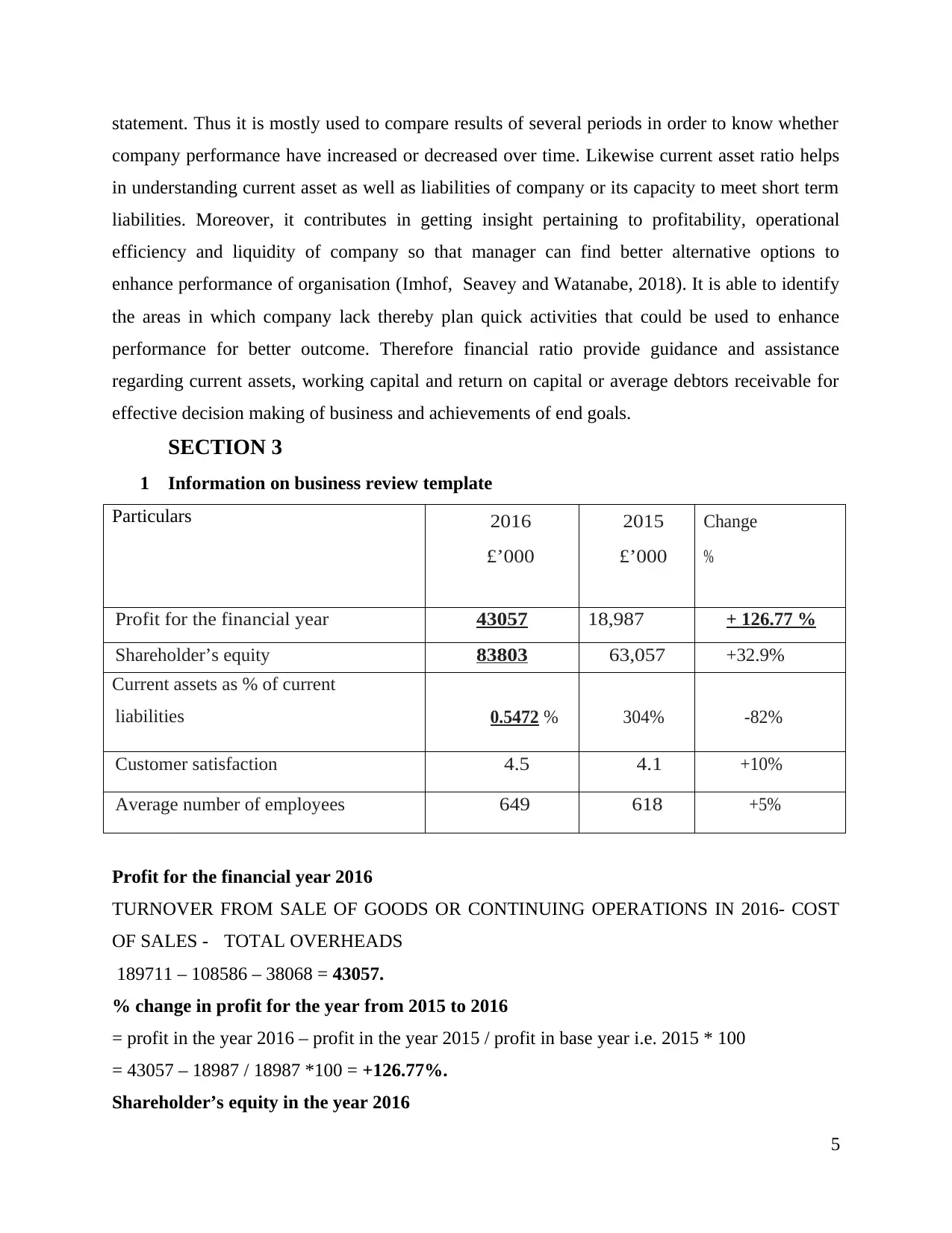
statement. Thus it is mostly used to compare results of several periods in order to know whether
company performance have increased or decreased over time. Likewise current asset ratio helps
in understanding current asset as well as liabilities of company or its capacity to meet short term
liabilities. Moreover, it contributes in getting insight pertaining to profitability, operational
efficiency and liquidity of company so that manager can find better alternative options to
enhance performance of organisation (Imhof, Seavey and Watanabe, 2018). It is able to identify
the areas in which company lack thereby plan quick activities that could be used to enhance
performance for better outcome. Therefore financial ratio provide guidance and assistance
regarding current assets, working capital and return on capital or average debtors receivable for
effective decision making of business and achievements of end goals.
SECTION 3
1 Information on business review template
Particulars 2016
£’000
2015
£’000
Change
%
Profit for the financial year 43057 18,987 + 126.77 %
Shareholder’s equity 83803 63,057 +32.9%
Current assets as % of current
liabilities 0.5472 % 304% -82%
Customer satisfaction 4.5 4.1 +10%
Average number of employees 649 618 +5%
Profit for the financial year 2016
TURNOVER FROM SALE OF GOODS OR CONTINUING OPERATIONS IN 2016- COST
OF SALES - TOTAL OVERHEADS
189711 – 108586 – 38068 = 43057.
% change in profit for the year from 2015 to 2016
= profit in the year 2016 – profit in the year 2015 / profit in base year i.e. 2015 * 100
= 43057 – 18987 / 18987 *100 = +126.77%.
Shareholder’s equity in the year 2016
5
company performance have increased or decreased over time. Likewise current asset ratio helps
in understanding current asset as well as liabilities of company or its capacity to meet short term
liabilities. Moreover, it contributes in getting insight pertaining to profitability, operational
efficiency and liquidity of company so that manager can find better alternative options to
enhance performance of organisation (Imhof, Seavey and Watanabe, 2018). It is able to identify
the areas in which company lack thereby plan quick activities that could be used to enhance
performance for better outcome. Therefore financial ratio provide guidance and assistance
regarding current assets, working capital and return on capital or average debtors receivable for
effective decision making of business and achievements of end goals.
SECTION 3
1 Information on business review template
Particulars 2016
£’000
2015
£’000
Change
%
Profit for the financial year 43057 18,987 + 126.77 %
Shareholder’s equity 83803 63,057 +32.9%
Current assets as % of current
liabilities 0.5472 % 304% -82%
Customer satisfaction 4.5 4.1 +10%
Average number of employees 649 618 +5%
Profit for the financial year 2016
TURNOVER FROM SALE OF GOODS OR CONTINUING OPERATIONS IN 2016- COST
OF SALES - TOTAL OVERHEADS
189711 – 108586 – 38068 = 43057.
% change in profit for the year from 2015 to 2016
= profit in the year 2016 – profit in the year 2015 / profit in base year i.e. 2015 * 100
= 43057 – 18987 / 18987 *100 = +126.77%.
Shareholder’s equity in the year 2016
5
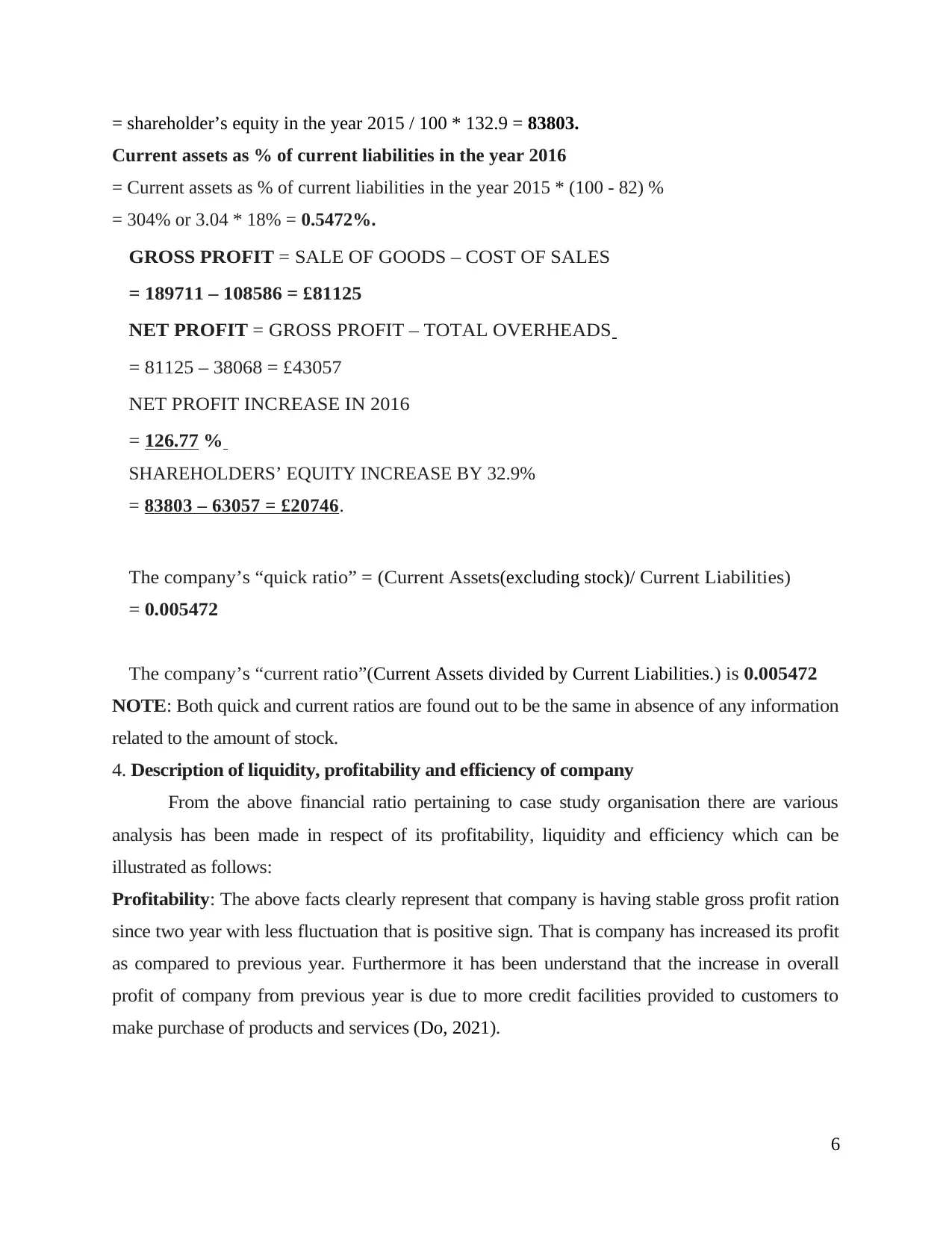
= shareholder’s equity in the year 2015 / 100 * 132.9 = 83803.
Current assets as % of current liabilities in the year 2016
= Current assets as % of current liabilities in the year 2015 * (100 - 82) %
= 304% or 3.04 * 18% = 0.5472%.
GROSS PROFIT = SALE OF GOODS – COST OF SALES
= 189711 – 108586 = £ 81125
NET PROFIT = GROSS PROFIT – TOTAL OVERHEADS
= 81125 – 38068 = £ 43057
NET PROFIT INCREASE IN 2016
= 126.77 %
SHAREHOLDERS’ EQUITY INCREASE BY 32.9%
= 83803 – 63057 = £20746.
The company’s “quick ratio” = (Current Assets(excluding stock)/ Current Liabilities)
= 0.005472
The company’s “current ratio”(Current Assets divided by Current Liabilities. ) is 0.005472
NOTE: Both quick and current ratios are found out to be the same in absence of any information
related to the amount of stock.
4. Description of liquidity, profitability and efficiency of company
From the above financial ratio pertaining to case study organisation there are various
analysis has been made in respect of its profitability, liquidity and efficiency which can be
illustrated as follows:
Profitability: The above facts clearly represent that company is having stable gross profit ration
since two year with less fluctuation that is positive sign. That is company has increased its profit
as compared to previous year. Furthermore it has been understand that the increase in overall
profit of company from previous year is due to more credit facilities provided to customers to
make purchase of products and services (Do, 2021).
6
Current assets as % of current liabilities in the year 2016
= Current assets as % of current liabilities in the year 2015 * (100 - 82) %
= 304% or 3.04 * 18% = 0.5472%.
GROSS PROFIT = SALE OF GOODS – COST OF SALES
= 189711 – 108586 = £ 81125
NET PROFIT = GROSS PROFIT – TOTAL OVERHEADS
= 81125 – 38068 = £ 43057
NET PROFIT INCREASE IN 2016
= 126.77 %
SHAREHOLDERS’ EQUITY INCREASE BY 32.9%
= 83803 – 63057 = £20746.
The company’s “quick ratio” = (Current Assets(excluding stock)/ Current Liabilities)
= 0.005472
The company’s “current ratio”(Current Assets divided by Current Liabilities. ) is 0.005472
NOTE: Both quick and current ratios are found out to be the same in absence of any information
related to the amount of stock.
4. Description of liquidity, profitability and efficiency of company
From the above financial ratio pertaining to case study organisation there are various
analysis has been made in respect of its profitability, liquidity and efficiency which can be
illustrated as follows:
Profitability: The above facts clearly represent that company is having stable gross profit ration
since two year with less fluctuation that is positive sign. That is company has increased its profit
as compared to previous year. Furthermore it has been understand that the increase in overall
profit of company from previous year is due to more credit facilities provided to customers to
make purchase of products and services (Do, 2021).
6
⊘ This is a preview!⊘
Do you want full access?
Subscribe today to unlock all pages.

Trusted by 1+ million students worldwide
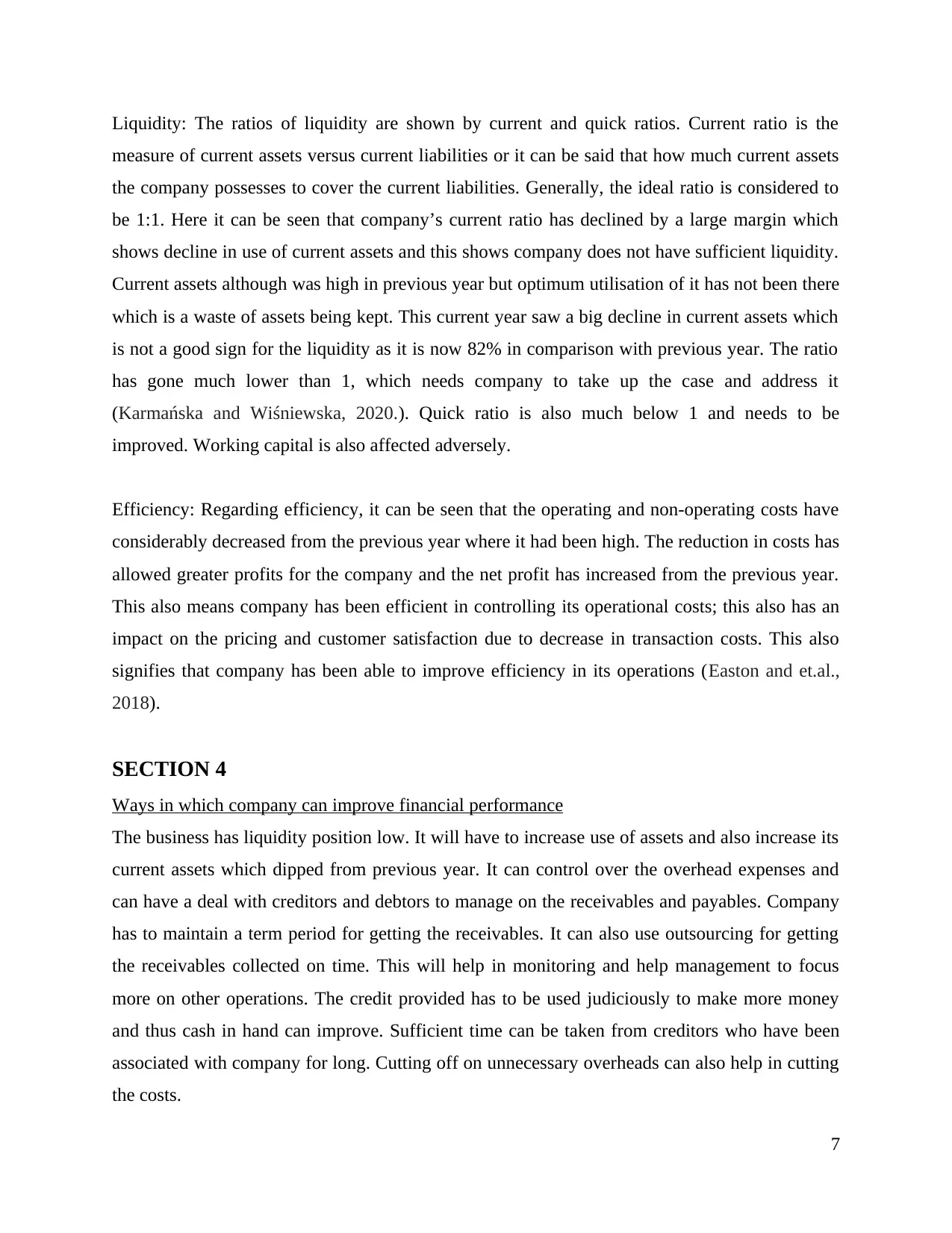
Liquidity: The ratios of liquidity are shown by current and quick ratios. Current ratio is the
measure of current assets versus current liabilities or it can be said that how much current assets
the company possesses to cover the current liabilities. Generally, the ideal ratio is considered to
be 1:1. Here it can be seen that company’s current ratio has declined by a large margin which
shows decline in use of current assets and this shows company does not have sufficient liquidity.
Current assets although was high in previous year but optimum utilisation of it has not been there
which is a waste of assets being kept. This current year saw a big decline in current assets which
is not a good sign for the liquidity as it is now 82% in comparison with previous year. The ratio
has gone much lower than 1, which needs company to take up the case and address it
(Karmańska and Wiśniewska, 2020.). Quick ratio is also much below 1 and needs to be
improved. Working capital is also affected adversely.
Efficiency: Regarding efficiency, it can be seen that the operating and non-operating costs have
considerably decreased from the previous year where it had been high. The reduction in costs has
allowed greater profits for the company and the net profit has increased from the previous year.
This also means company has been efficient in controlling its operational costs; this also has an
impact on the pricing and customer satisfaction due to decrease in transaction costs. This also
signifies that company has been able to improve efficiency in its operations (Easton and et.al.,
2018).
SECTION 4
Ways in which company can improve financial performance
The business has liquidity position low. It will have to increase use of assets and also increase its
current assets which dipped from previous year. It can control over the overhead expenses and
can have a deal with creditors and debtors to manage on the receivables and payables. Company
has to maintain a term period for getting the receivables. It can also use outsourcing for getting
the receivables collected on time. This will help in monitoring and help management to focus
more on other operations. The credit provided has to be used judiciously to make more money
and thus cash in hand can improve. Sufficient time can be taken from creditors who have been
associated with company for long. Cutting off on unnecessary overheads can also help in cutting
the costs.
7
measure of current assets versus current liabilities or it can be said that how much current assets
the company possesses to cover the current liabilities. Generally, the ideal ratio is considered to
be 1:1. Here it can be seen that company’s current ratio has declined by a large margin which
shows decline in use of current assets and this shows company does not have sufficient liquidity.
Current assets although was high in previous year but optimum utilisation of it has not been there
which is a waste of assets being kept. This current year saw a big decline in current assets which
is not a good sign for the liquidity as it is now 82% in comparison with previous year. The ratio
has gone much lower than 1, which needs company to take up the case and address it
(Karmańska and Wiśniewska, 2020.). Quick ratio is also much below 1 and needs to be
improved. Working capital is also affected adversely.
Efficiency: Regarding efficiency, it can be seen that the operating and non-operating costs have
considerably decreased from the previous year where it had been high. The reduction in costs has
allowed greater profits for the company and the net profit has increased from the previous year.
This also means company has been efficient in controlling its operational costs; this also has an
impact on the pricing and customer satisfaction due to decrease in transaction costs. This also
signifies that company has been able to improve efficiency in its operations (Easton and et.al.,
2018).
SECTION 4
Ways in which company can improve financial performance
The business has liquidity position low. It will have to increase use of assets and also increase its
current assets which dipped from previous year. It can control over the overhead expenses and
can have a deal with creditors and debtors to manage on the receivables and payables. Company
has to maintain a term period for getting the receivables. It can also use outsourcing for getting
the receivables collected on time. This will help in monitoring and help management to focus
more on other operations. The credit provided has to be used judiciously to make more money
and thus cash in hand can improve. Sufficient time can be taken from creditors who have been
associated with company for long. Cutting off on unnecessary overheads can also help in cutting
the costs.
7
Paraphrase This Document
Need a fresh take? Get an instant paraphrase of this document with our AI Paraphraser
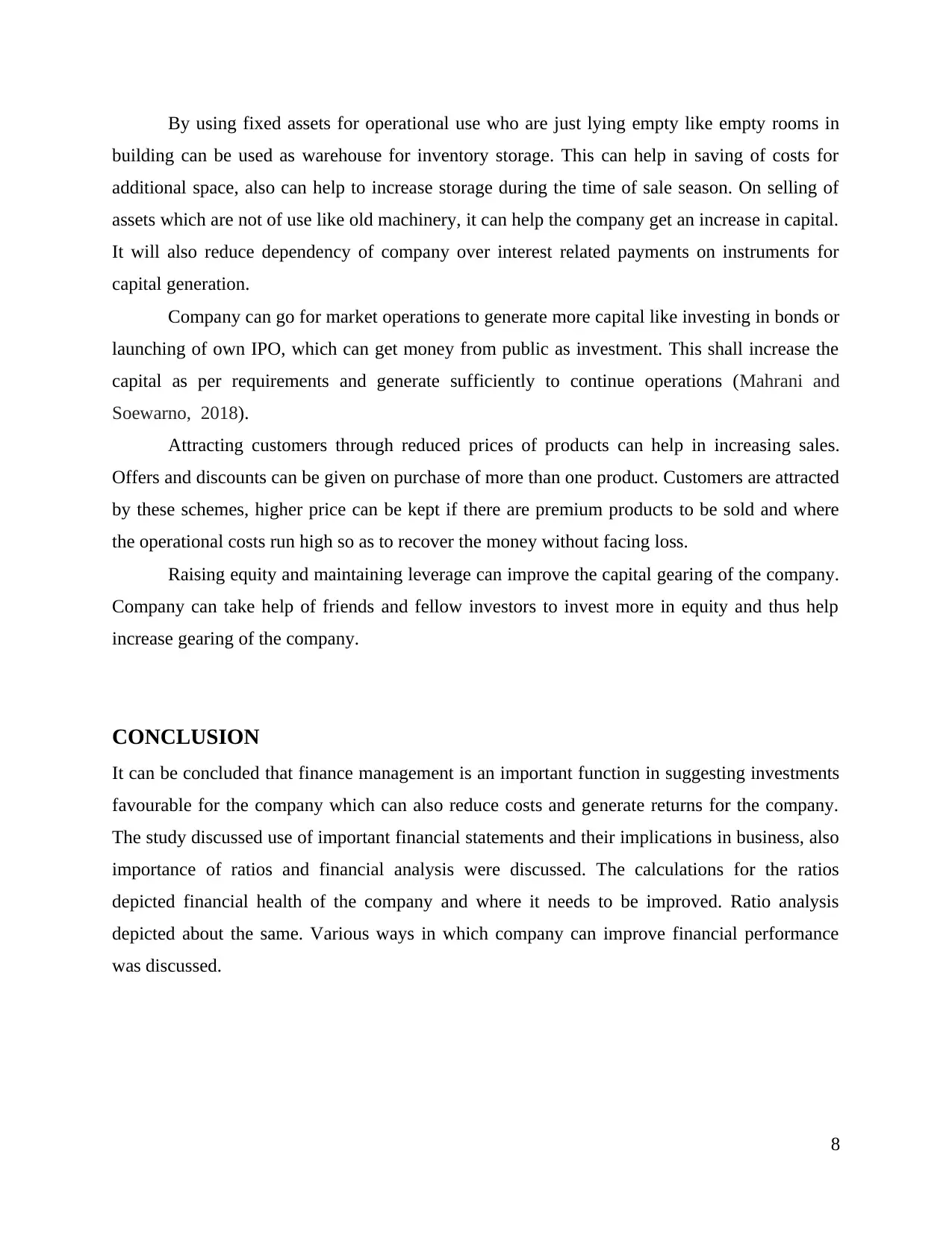
By using fixed assets for operational use who are just lying empty like empty rooms in
building can be used as warehouse for inventory storage. This can help in saving of costs for
additional space, also can help to increase storage during the time of sale season. On selling of
assets which are not of use like old machinery, it can help the company get an increase in capital.
It will also reduce dependency of company over interest related payments on instruments for
capital generation.
Company can go for market operations to generate more capital like investing in bonds or
launching of own IPO, which can get money from public as investment. This shall increase the
capital as per requirements and generate sufficiently to continue operations (Mahrani and
Soewarno, 2018).
Attracting customers through reduced prices of products can help in increasing sales.
Offers and discounts can be given on purchase of more than one product. Customers are attracted
by these schemes, higher price can be kept if there are premium products to be sold and where
the operational costs run high so as to recover the money without facing loss.
Raising equity and maintaining leverage can improve the capital gearing of the company.
Company can take help of friends and fellow investors to invest more in equity and thus help
increase gearing of the company.
CONCLUSION
It can be concluded that finance management is an important function in suggesting investments
favourable for the company which can also reduce costs and generate returns for the company.
The study discussed use of important financial statements and their implications in business, also
importance of ratios and financial analysis were discussed. The calculations for the ratios
depicted financial health of the company and where it needs to be improved. Ratio analysis
depicted about the same. Various ways in which company can improve financial performance
was discussed.
8
building can be used as warehouse for inventory storage. This can help in saving of costs for
additional space, also can help to increase storage during the time of sale season. On selling of
assets which are not of use like old machinery, it can help the company get an increase in capital.
It will also reduce dependency of company over interest related payments on instruments for
capital generation.
Company can go for market operations to generate more capital like investing in bonds or
launching of own IPO, which can get money from public as investment. This shall increase the
capital as per requirements and generate sufficiently to continue operations (Mahrani and
Soewarno, 2018).
Attracting customers through reduced prices of products can help in increasing sales.
Offers and discounts can be given on purchase of more than one product. Customers are attracted
by these schemes, higher price can be kept if there are premium products to be sold and where
the operational costs run high so as to recover the money without facing loss.
Raising equity and maintaining leverage can improve the capital gearing of the company.
Company can take help of friends and fellow investors to invest more in equity and thus help
increase gearing of the company.
CONCLUSION
It can be concluded that finance management is an important function in suggesting investments
favourable for the company which can also reduce costs and generate returns for the company.
The study discussed use of important financial statements and their implications in business, also
importance of ratios and financial analysis were discussed. The calculations for the ratios
depicted financial health of the company and where it needs to be improved. Ratio analysis
depicted about the same. Various ways in which company can improve financial performance
was discussed.
8
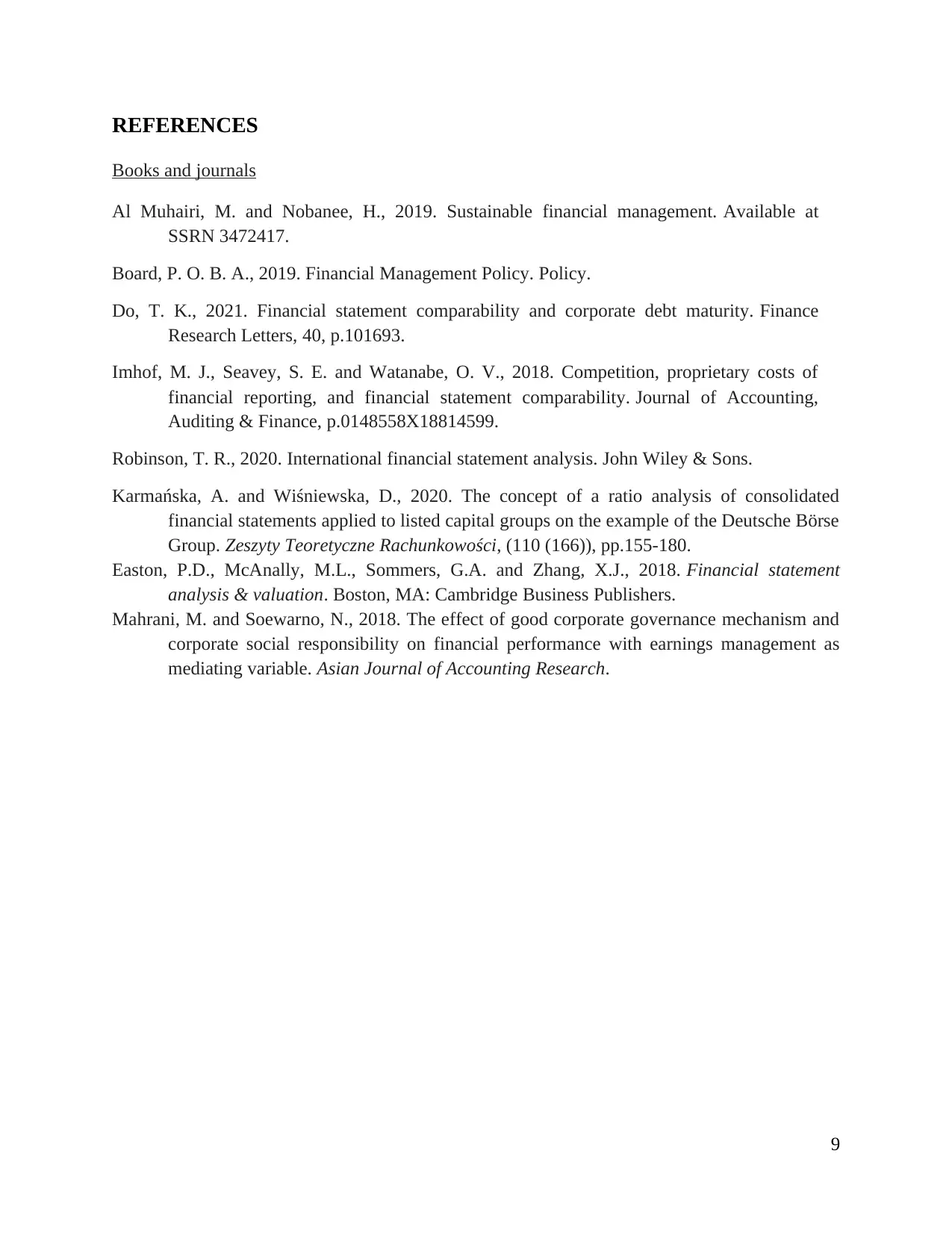
REFERENCES
Books and journals
Al Muhairi, M. and Nobanee, H., 2019. Sustainable financial management. Available at
SSRN 3472417.
Board, P. O. B. A., 2019. Financial Management Policy. Policy.
Do, T. K., 2021. Financial statement comparability and corporate debt maturity. Finance
Research Letters, 40, p.101693.
Imhof, M. J., Seavey, S. E. and Watanabe, O. V., 2018. Competition, proprietary costs of
financial reporting, and financial statement comparability. Journal of Accounting,
Auditing & Finance, p.0148558X18814599.
Robinson, T. R., 2020. International financial statement analysis. John Wiley & Sons.
Karmańska, A. and Wiśniewska, D., 2020. The concept of a ratio analysis of consolidated
financial statements applied to listed capital groups on the example of the Deutsche Börse
Group. Zeszyty Teoretyczne Rachunkowości, (110 (166)), pp.155-180.
Easton, P.D., McAnally, M.L., Sommers, G.A. and Zhang, X.J., 2018. Financial statement
analysis & valuation. Boston, MA: Cambridge Business Publishers.
Mahrani, M. and Soewarno, N., 2018. The effect of good corporate governance mechanism and
corporate social responsibility on financial performance with earnings management as
mediating variable. Asian Journal of Accounting Research.
9
Books and journals
Al Muhairi, M. and Nobanee, H., 2019. Sustainable financial management. Available at
SSRN 3472417.
Board, P. O. B. A., 2019. Financial Management Policy. Policy.
Do, T. K., 2021. Financial statement comparability and corporate debt maturity. Finance
Research Letters, 40, p.101693.
Imhof, M. J., Seavey, S. E. and Watanabe, O. V., 2018. Competition, proprietary costs of
financial reporting, and financial statement comparability. Journal of Accounting,
Auditing & Finance, p.0148558X18814599.
Robinson, T. R., 2020. International financial statement analysis. John Wiley & Sons.
Karmańska, A. and Wiśniewska, D., 2020. The concept of a ratio analysis of consolidated
financial statements applied to listed capital groups on the example of the Deutsche Börse
Group. Zeszyty Teoretyczne Rachunkowości, (110 (166)), pp.155-180.
Easton, P.D., McAnally, M.L., Sommers, G.A. and Zhang, X.J., 2018. Financial statement
analysis & valuation. Boston, MA: Cambridge Business Publishers.
Mahrani, M. and Soewarno, N., 2018. The effect of good corporate governance mechanism and
corporate social responsibility on financial performance with earnings management as
mediating variable. Asian Journal of Accounting Research.
9
⊘ This is a preview!⊘
Do you want full access?
Subscribe today to unlock all pages.

Trusted by 1+ million students worldwide
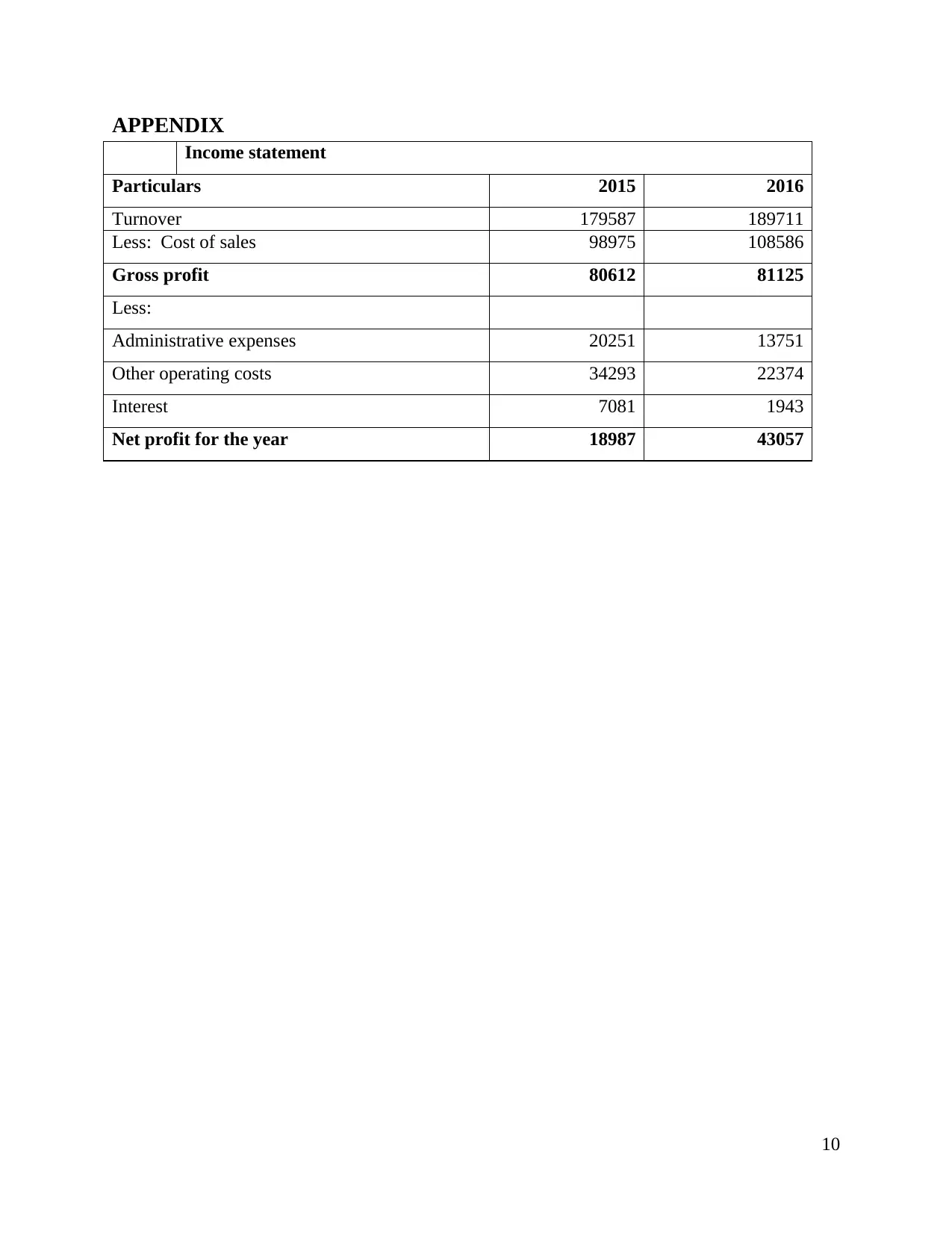
APPENDIX
Income statement
Particulars 2015 2016
Turnover 179587 189711
Less: Cost of sales 98975 108586
Gross profit 80612 81125
Less:
Administrative expenses 20251 13751
Other operating costs 34293 22374
Interest 7081 1943
Net profit for the year 18987 43057
10
Income statement
Particulars 2015 2016
Turnover 179587 189711
Less: Cost of sales 98975 108586
Gross profit 80612 81125
Less:
Administrative expenses 20251 13751
Other operating costs 34293 22374
Interest 7081 1943
Net profit for the year 18987 43057
10
1 out of 10
Related Documents
Your All-in-One AI-Powered Toolkit for Academic Success.
+13062052269
info@desklib.com
Available 24*7 on WhatsApp / Email
![[object Object]](/_next/static/media/star-bottom.7253800d.svg)
Unlock your academic potential
Copyright © 2020–2025 A2Z Services. All Rights Reserved. Developed and managed by ZUCOL.



